I am one of the lucky ones.
Each year, untold thousands of visitors go to Alaska to see Denali, the great towering mountain that folks in the lower 48 know as Mount McKinley. And each year, most go home disappointed. Only about 20 percent of visitors to Alaska ever see the mountain, which is usually shrouded in deep clouds. Most of those that do see it catch only a passing glimpse.
But somehow, for some reason, the clouds parted for me. Over the next five days, I saw Denali time after time 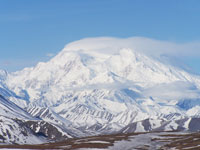 — from afar, from up close, even from above. I am one of the lucky ones.
— from afar, from up close, even from above. I am one of the lucky ones.
This is a story of five breathtaking days in the Last Frontier, treading deep into the backcountry of Alaska and Denali National Park. It’s a story of Mount McKinley and the thousands of wild animals that thrive in its shadow. It’s a story of hikes and helicopters, glaciers, trains and the rugged, adventurous spirit of the 50th state.
This is a story of the Alaska that can’t be seen from the deck of a cruise ship. But if you ever do see it, if you’re lucky enough, I’m sure you will agree that there is nothing more beautiful on earth.
Out of Anchorage
I am traveling in Alaska as a guest of Holland America Lines and Gray Line of Alaska, Holland America’s wholly owned subsidiary that operates the land portion of its cruise-tour itineraries. Though many of the land tours are packaged and escorted, my particular tour is individual, allowing me to spend my time and see the sites at will.
I flew in to Anchorage yesterday afternoon, and today I’m making the trip from there to Denali National Park by motorcoach. Because it’s early June, toward the beginning of the tourist season, the state is not overly crowded, and there are only a handful of other passengers on the six-hour drive to the park entrance.
As we make our way, our driver, Allen Kanne, gives us some background on the state. Kanne, like most tourism workers in Alaska, is from the lower 48 and is a school counselor in Wichita, Kansas, during the remainder of the year. He has a great appreciation for the wonders of Alaskan summers.
“June is the nicest month to come,” he tells us. “That’s when it’s driest and has the most daylight.”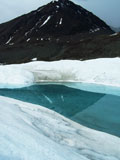
We’re in mid-drive when Kanne suddenly slows down, pulling the bus over to the shoulder. We all pile off the bus, and he points to a peak far off in the distance.
“That is Denali,” he says. “You’re lucky. You rarely see the mountain. I did this drive 30 times last year and only saw it three times.”
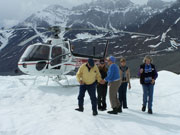 |
The native Athabascan people of this area gave the mountain the name Denali, meaning “the great one,” hundreds of years ago. Today, most Alaskans still refer to it by that name. At 20,320 feet, its peak is the highest point in North America. Though Mount Everest’s peak is some 9,000 feet higher, Denali has the largest base-to-peak relief on earth, which means that no matter where you stand in the world, you’ll never look up at anything higher than Mount McKinley.
About halfway to the park, we stop at Talkeetna Lodge for a coffee break. The lodge has a beautiful view of the mountain range and, on a good day, Mount McKinley.
Again, we are lucky — the clouds separate while we stand on the balcony, revealing the mountain in the distance. The valley between it and us is full of spruce and birch trees. Small lakes, creeks and ponds spread out across the valley floor. It is, without a hint of exaggeration, picture perfect.
A wild ride
I transfer at the park to another bus that will take me to Denali Backcountry Lodge, where I will spend the next two days. This is an old school bus, whose driver makes the five-hour trip 95 miles into the park once a day to bring visitors to the secluded property.
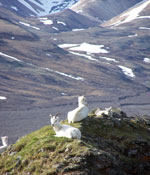 |
It would be a long drive, except that the scenery is stunning. We are surrounded by mountains, the Alaska Range on our left and the Outer Range on our right. Somewhere, Denali lingers in the distance.
Along the way, we will also stop to check out the park’s wildlife.
“There are five big animals that we look for up here: moose, bear, Dall sheep, caribou and wolf,” our driver, Larry, tells us. “There are 92 wolves; about 350 bears; and 2,500 sheep, moose and caribou in the park.”
It doesn’t take long for us to begin spotting wildlife: first a bull moose, then a grizzly bear, a golden eagle and a wolf. Later on, we find a whole herd of Dall sheep, climbing precariously up the sides of a narrow rock outcropping.
Even when there are no animals in sight, the drive is relaxing and gives me a chance to take in some of the intangible treasures of Alaska.
Up here, things are just different. Up here, the rest stops are more like outhouses, metal shacks with a fiberglass seat perched above a hole in the ground. Up here, no one is a local, and no one has a desk job, or a care in the world.
As we approach the lodge, we get an absolutely miraculous opening in the clouds — in the right place at the right time — that affords us a full view of Mount McKinley. This is the opposite side of the mountain than what we saw this morning. From here, the size of what we see makes its full impact. McKinley dwarfs the other mountains we’ve been driving between all day, towering like a mother bear over her cubs.
“They tell me that from here, it’s 22 miles to the base of the mountain,” Larry tells us. “There’s nowhere else where you’re going to get any closer.”
After a full afternoon of driving, we reach our secluded destination.
|
A private car on the Alaska Railroad
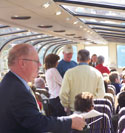 One of the most popular ways to travel between Anchorage and Denali is on the Alaska Railroad. I took the eight-hour trip by train back from the park on Holland America’s private train car. The train is a fantastic way to travel, with wide seats and dome windows. There’s a bar in front and a dining car below. Two Holland American staff members, a car attendant and a drink steward kept us entertained with songs, jokes and commentary about the landscape we passed through. “You aren’t going to find this river on very many maps,” car attendant Kim said as we crossed a small bridge over the Indian River. “The only people that know about it are railroad people and fishermen.” Along the way, we passed several glaciers, as well as small mining and hunting settlements. I saw more moose while I was aboard the train than I did in any other place in Alaska. And one last time, we came around a bend at the perfect moment to see an incredible view of Mount McKinley. |
“Welcome to the end of the road,” owner Sham Idnani says, greeting us as we pile off the bus at Denali Backcountry Lodge. “You can go 600 miles north or 600 miles west and you’ll find nothing.”
A slice of heaven
My legs ache and throb and ache some more. But it’s a good ache — that deep satisfying feeling that lets you know you’ve accomplished something significant.
I have just returned from a guided hike to Eagle Point, one of the highest places overlooking the Denali Backcountry Lodge. The hike is technically categorized as “moderate,” but our guide and naturalist, J.D., is known for pushing the pace. During our four-hour hike, we climbed to an elevation of 1,600 feet, stopping along the way to admire the scenery.
J.D. says that hikers on the Eagle Point trail often encounter wildlife. We didn’t see any today, but scat along the trail indicated that animals were there recently. J.D. identified the droppings — some from a bear, some from moose and some from a wolf.
The hike is just one of the activities offered to guests at Denali Backcountry Lodge. Other options are photography expeditions, gold panning, mountain biking and naturalist lectures. All of the activities, as well as three hearty meals, are included in an overnight stay.
The lodge is one of only a handful of private properties inside Denali National Park. The land on which this lodge sits was previously a mining claim and was grandfathered in as private property when the park was established in 1917. Today, the property has 30 cedar cabins, all outfitted with heat, electricity and full restrooms, and with bedding and decor that is both rustic and comfortable. There is no television here, and I can’t imagine ever wanting one.
After the daytime activities and dinner, guests spend time mingling in the lodge, drinking wine, playing games or sitting around an outdoor fireplace. Because we are so far north, there are nearly 20 hours of daylight in June; even though the sun sets for the remaining four hours, it never gets truly dark.
At 10:30 p.m., the sky is cloudless, the sun shines brightly overhead, and the air is a comfortable 55 degrees Fahrenheit. It doesn’t feel like nighttime, so it hasn’t occurred to me to go to sleep. But the deep fatigue beginning to set in reminds me that my body needs a rest. Tomorrow morning, I will leave the lodge and return to the park entrance. It’s a pity, because I feel that I could stay here forever.
Tasting a glacier
After an equally inspiring drive back to the park entrance yesterday, I spend a night at McKinley Chalet Resort, a hotel owned by Gray Line that is the company’s nerve center for operations in the park. From here, you can book all kinds of excursions, such as hikes, sightseeing tours, folklore shows and traditional Alaskan dinners. I will be taking the ultimate “flightseeing” adventure — a helicopter ride to a glacier.
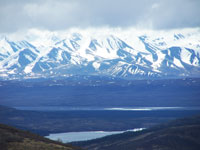 |
I board the chopper with four other travelers from Macon, Georgia, and our pilot, Loretta Knapp. Loretta is young and the first Alaska native I’ve met here. During the off-season, she flies a chopper for a commercial oil rig.
We take off, and quickly climb to 4,900 feet. From this altitude, we pass over the snow-capped tops of brown mountains. To see mountains from above is extraordinary — instead of simply noticing their size, we admire their contour and relief as they run through the countryside like a backbone. Loretta also begins to point out the numerous glaciers that live in these mountains, huge blocks of blue ice blanketed with fresh snow.
“This is all glacial moraine,” she tells us. “It’s basically everything that the glaciers have pushed out of their way as they’ve moved along.”
After about 20 minutes of flying, we land on one of the glaciers, on a small strip of ice between two long glacial lakes. It’s like a moonscape up here — this ice all around us is brilliant white, but the puddles, ponds and lakes glow in a turquoise blue. The view is incredible, and the only thing we hear is the slow trickling of water somewhere in the distance.
“This glacier is about 17 miles long,” Loretta says. “The ice we’re standing on is about 500 feet thick.”
It’s also pure, as pure as water ever gets in nature. Loretta encourages us to bend down and sip some of the melted water out of the pools on the ground. The water is cold, fresh and exhilarating.
After our return flight, we are all aflutter.
“That made my whole trip,” says Millie Sheeley, one of my fellow passengers. “I can’t imagine anything more exciting than that.”
I can’t imagine it, either. All that I can think of is how incredible this day has been, how incredible this place has been and how lucky I have been to see it all.
Gray Line of Alaska
(888) 452-1737
www.graylinealaska.com









